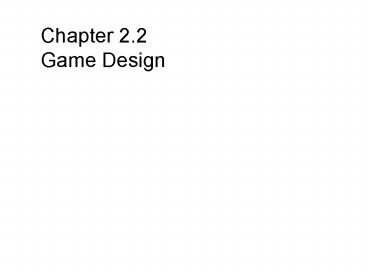Chapter 2.2 Game Design PowerPoint PPT Presentation
Title: Chapter 2.2 Game Design
1
Chapter 2.2Game Design
2
Overview
- This introduction covers
- Terms
- Concepts
- Approach
- All from a workaday viewpoint
3
The Language of Games
- Debate continues over high-level views
- Lack of standard (concrete) definitions
- Game (Interactions to elicit emotions?)
- Play (Object of rule-bound play?)
- Aesthetics (Emotional responses during play?)
- High-level concepts tricky to articulate
4
The Language of Games
- Why do we play?
- What is the nature of games?
- Not our focus in this class
- How is a game formed of parts?
- Thats what we care about here!
- Computer games are an art form
- The art of making interactive dynamic models!
5
Games Exist in a Frame
- The border of a games context
- Inside the frame is in the game
- Outside the frame is real life
- The world of the interactive dynamic model
- Choices have outcomes in the frame
- Varying consequences/weights
- Meaningful choices!
6
A Player-Game Model
- A model of the player game relationship
7
Play Mechanics
- Gameplay
- Feelings of playing a particular game
- Activities engaged in a particular game
- (Play/game) Mechanics
- Specific to game activities
- What the player does
- Core Mechanics are the central activities
8
Seven Stages of Action (Don Norman, DOET)
- Execution
- Intention to act
- Sequence of action
- Execution of action sequence
- Evaluation
- Evaluating interpretations
- Interpreting perceptions
- Perceiving states
9
Designer and Player Models
- Systems are built from designer mental models
- Design models may only anticipate player goals
- Players build mental models from mechanics
- Based on interactions
10
Goals and Objectives
- Objectives and goals can differ
- Players goals reflect their understanding of the
game - Designers must consider how the game communicates
with players
11
Aside Resources
- Things used by agents to reach goals
- To be meaningful, they must be
- Useful provide some value
- Limited in total or rate of supply
- KEY Needed, but limited!
12
Premise Sets Context for Model
- The metaphors of action and setting
- Concrete (e.g., Halo back-story)
- Activity based (e.g., Madden)
- Abstract (e.g., Tetris)
- Directs the player experience
- Provides a context in which mechanics fit
- Players map game states to the premise
13
Player Strategy
- People usually reason with commonsense
- A view of linear causation cause and effect
- Complex systems do not behave linearly
- Players need information to support linear
strategy - Game theory assumes rational players
- But does not assume perfect knowledge
14
Aside HCI and Cognitive Ergonomics
- HCI Human-Computer Interaction
- Study of
- Communication between users and computers
- How people design, build, and use interfaces
- Better support for cooperative work
- Cognitive Ergonomics
- Analyzes the cognitive representations and
processes involved with performing tasks
15
Norman, again (DOET Design of Everyday Things)
- Normans five principles of design
- Visibility
- Making the parts visible
- Mappings
- Understandable relationships between controls and
actions - Affordances
- The perceived uses of an object
- Constraints
- Prevent the user from doing things they shouldnt
- Feedback
- Reporting what has been done and accomplished
16
Systems Design
- Two general approaches to design
- Special case
- Experiences built one scene/level at a time
- Anticipate states while pre-scripting events
- Solved by discovering the intentions of the
designer - Systemic
- General behaviors are designed
- Scenes/Levels are specific configurations
- Some events may still be pre-scripted
- Solved by understanding the system
17
Systems and Dynamics
- Generalizing dynamic behavior is hard
- Dynamics determined by a given architecture
- Feedback/control loops with player in loop
- Emergent complexity
- Behaviors that cannot be predicted simply from
the rules of a system - E.g., John Conways Game of Life
18
Systems and Feedback
- Negative feedback
- Stabilizes the game
- Forgives the loser
- Prolongs the game
- Magnifies late successes
- Positive feedback
- Destabilizes the game
- Rewards the winner
- Can end the game
- Magnifies early successes
19
Design is all about Working within Constraints!
- E.g., Platform
- General description of hardware and software
- E.g., Game Saves
- Save triggers
- Save-anywhere
- Save points
- Coded text saves
20
Design to Different Audiences
- Why We Play Games Nicole Lazzaro
- Internal experience
- Enjoyment from visceral activities
- Hard fun
- Challenge of strategy and problem solving
- Easy fun
- Intrigue and curiosity exploration and
adventure - Social experience
- Stimulating social faculties competition,
teamwork, bonding, and recognition
21
Rest of Chapter
- Creativity Section Brainstorming
- Generating ideas without discrimination
- Evaluation after elaboration
- Can be unfocused
- Communication and Psychology
- Useful tidbits
- Lots of courses, books, etc.

